Today, Kristen takes us through what she believes are the most underrated abilities in casual Commander.
When I think of casual Commander, I think of creatures. Creatures are the bread and butter of casual builds, and a lot of games with this ethos end when a player uses combat damage as the win condition — even when those decks have alternate game plans.
As the format has evolved over the last few years, I’ve noticed some interesting developments in how the average game goes. Some I’ve written about already — like in my article about how the evolution of playing mono-white says a lot about where Commander is as a format.
Today, I’d like to further develop that line of thought and cover what I deem to be the most underrated abilities in casual Commander. But first — which abilities are overrated, and how does that shed light on what’s underrated?
Overrated, I’m Afraid
A couple years ago, the average Commander game length was much longer than it is today. I’ve noticed, personally, that I used to play a lot more recursion for these games. Part of that is a personal choice — my playgroups and I prefer to play more games over playing one longer game, but part of it is that recurring smaller value creatures can be a little “durdly” these days.
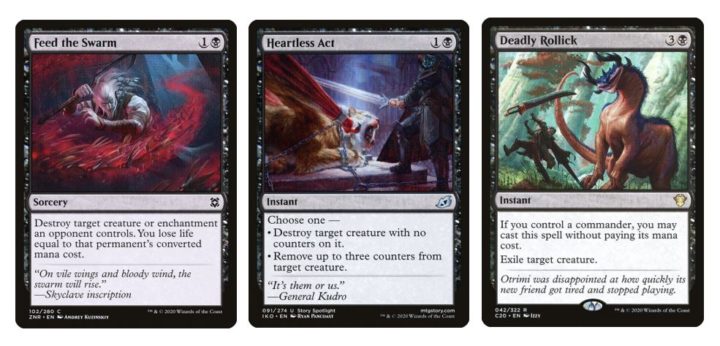
Part of why games are quicker is the efficacy and abundance of cheap interaction. Every set sees more removal spells printed, and some amount of the time, these spells are good enough to fit into decks.
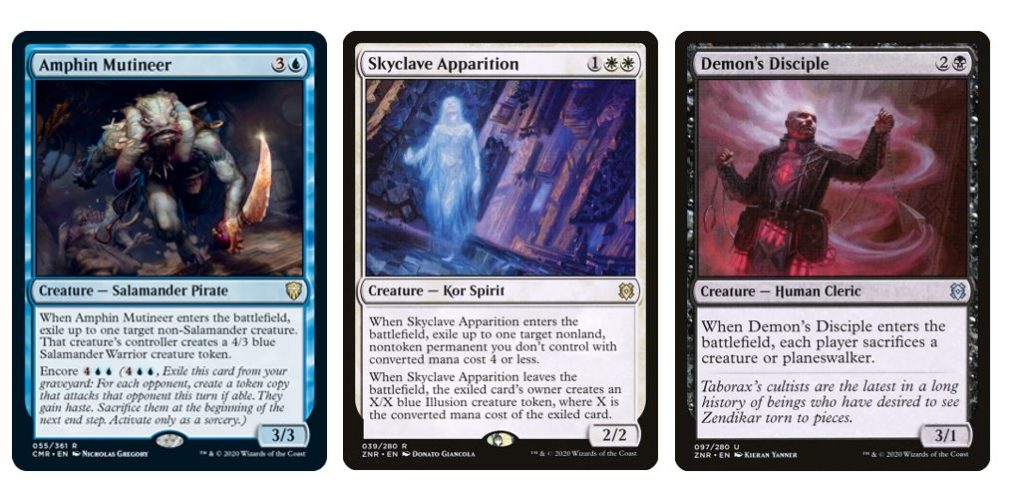
We’re also seeing a lot more exile removal. Between creature-based options like Amphin Mutineer and Skyclave Apparition and the likes of Dire Tactics and Despark, exile removal is increasingly common, and it’s equally powerful early or late in the game.
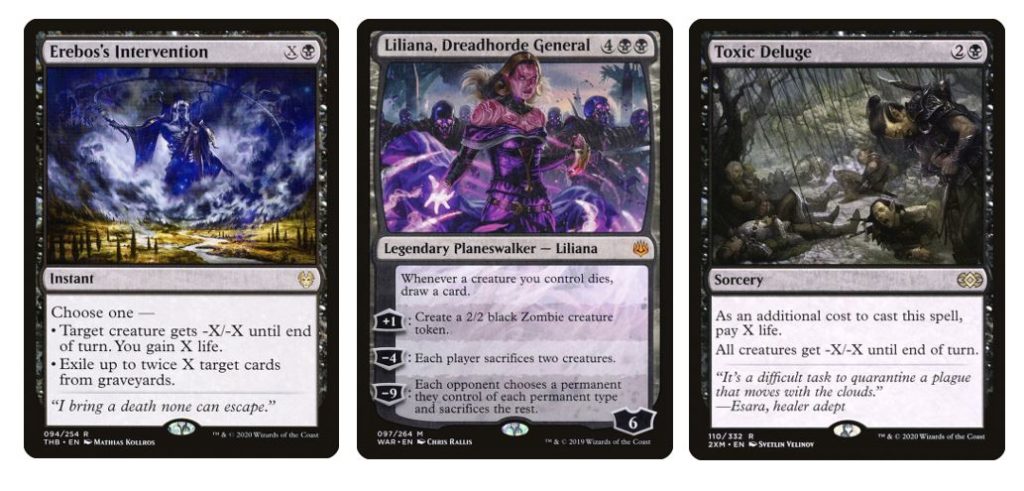
On top of that, redundancy for Plaguecrafter in the form of Demon’s Disciple, reprints of Toxic Deluge, and more recent -X/-X spells like Erebos’s Intervention all offer a variety of ways to answer Indestructible.
Indestructible, then, is one of the keywords I think is currently a little overrated. In times past, making your stuff indestructible using permanents like auras and equipment was a pretty strong move most of the time. Sometimes, just praying to resolve an indestructible threat like Avacyn, Angel of Hope was enough to win a game.

Given the increase in cheap interaction and the sheer quantity of effects that get around Indestructible, destroy effects are a little less effective than you’d think. What’s more, exile wraths are starting to see more play, too, and Ajani, Strength of the Pride offers a fantastic effect that’s easily unlocked. I’ve actually started putting Descend Upon the Sinful back into more builds, and I love having access to it. (Green getting Heroic Intervention may or may not have been part of that decision process!)
Hexproof is the leading protection effect players value, and I think it’s overtaken indestructible due to the increase in the ratio of single-target spells to board wipes. The thing is, though, every player worth their salt is now wise to Lightning Greaves and Swiftfoot Boots, and so you’re often just asking for removal by playing permanent-based effects to combat these removal spells.
Instead, I feel that Hexproof has started to excel in the realm of interaction. Taking spells like Rebuff the Wicked, Faith’s Shield, Deflecting Swat, or Blossoming Defense is a strong move, and having cheap interaction feels great. When combined with Lightning Greaves, you can stand to benefit a good proportion of the time by baiting out the removal spell, only to counter or redirect it.
Planar Cleansing
This leads me back around to board wipes. With the quantity and quality of single-target interaction being (necessarily) higher — and games being comparatively shorter — how you bounce back from being “stone-aged” is now the litmus test for whether you can make your comeback to win a game of casual commander.
Generally speaking, most games I see and take part in tend to go one of two ways: either the players land back-to-back wraths leading to the “classic” grindier gameplay; or wraths are uncommon, but players instead engage in a lot of one-for-one exchanges, with the game being won on who has the best card advantage engine in place. Either way, creatures rarely survive more than one turn cycle unless an archenemy has been identified.
Consequently, the player who can rebuild quickest after losing their board tends to just take over the game. You might wonder, then, if holding back is a better strategy. At certain tables it might be, but it’s a trick that you can only really pull off once before people wise up to it. So, as is the case when playing against controlling decks in other formats, not deploying resources in fear of a wipe or removal is another easy way to lose a game. Either the other players gain a bigger tempo advantage, or they just kill you because they fear what’s in your hand.
So, what’s the secret to getting more impact out of your creatures when so many of the creatures we play these days are must-answer haymakers?
Haste
While it’s true that one answer to the conundrum is to run more recursion, a balance has to be struck, and sometimes, your recursion might just be dead in hand. I encourage all decks to run a little recursion–or more, at stronger tables–but I believe Haste to be the more underrated answer to getting value out of your creatures.
As we’ve discussed, you rarely get to untap with your full board. Whether it’s wiped completely, or picked apart by single-target removal, it’s not going to be the same as when you pass the turn.
The solution is to play creatures with Haste, and effects that grant your board Haste. Reaching peak synergy and being unable to take advantage of it due to summoning sickness can be an exercise in frustration.
Instead, with Haste, you can execute your plans in relative peace. Sure, people will still have interaction, but generally speaking, Haste is not on everyone’s radar all the time, and if people feel like they need to tap out to keep up in tempo, they’ll often do so based on the calculation that they have time before your creatures lose summoning sickness.
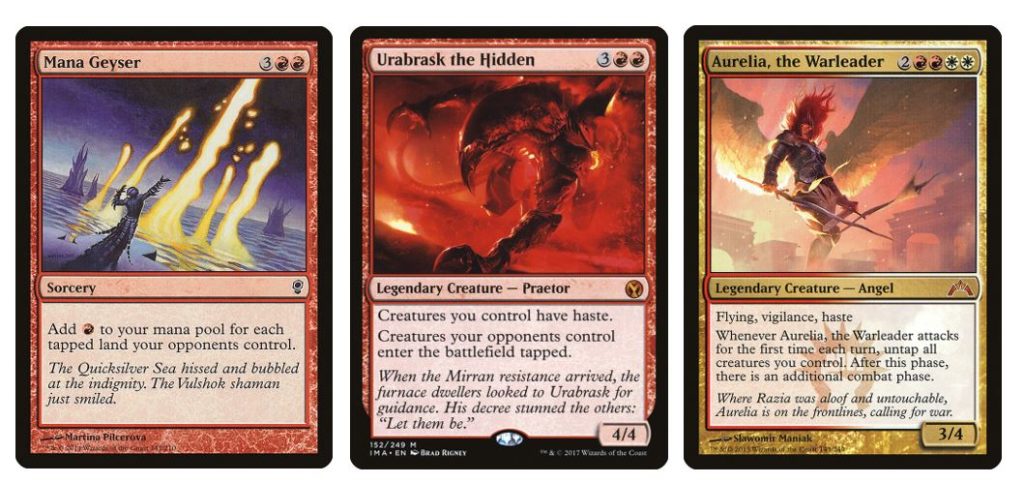
Playing out your creatures and attacking when players are tapped out, then, is the key to unlocking the potential of Haste, and let me tell you — the potential is there. If you’re in red, Mana Geyser can really kick things off, and pairing that extra mana with Urabrask and a bunch of creatures can be all you need to deal with a player who looks to be out of reach.
Consider, also, how back-breaking effects like Thalia, Heretic Cathar and Authority of the Consuls can be. When employed alongside Haste in your builds, it can often feel like you’re two turns ahead of where your opponents are, which is a huge tempo swing.
Sneak Attack
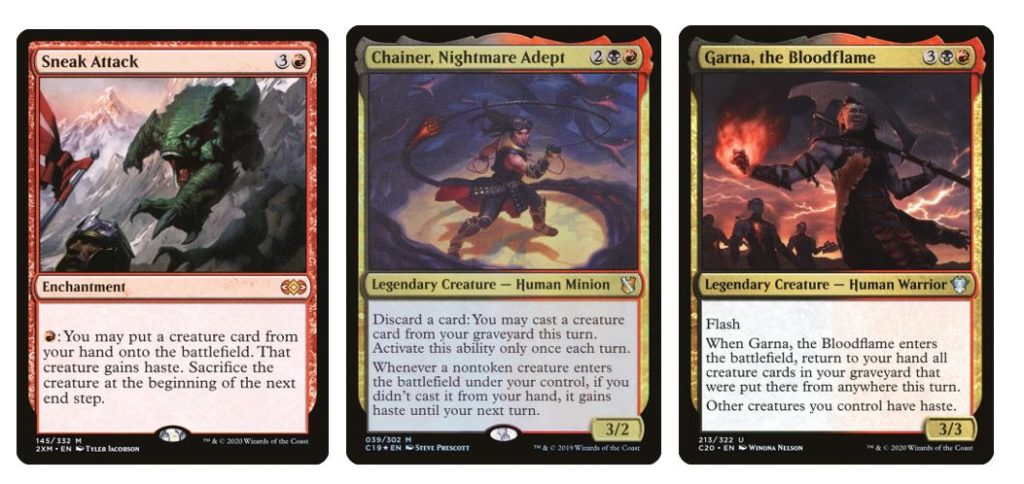
One of my favorite decks to play is Chainer, Nightmare Adept, and the native haste offered to the creatures in the deck by Anger, Chainer himself, Garna, the Bloodflame, and Sneak Attack is vital to the deck being able to close a game.
What’s more, getting triggers ahead of time can be deadly. Doubling up on Inferno Titan and Grave Titan triggers can be a huge tempo swing, and being able to resolve a Living Death and still attack afterwards is deadly. It also lets you get value out of risky investments — Etali, Primal Storm is difficult to untap with, and landing her and being able to immediately swing can offset the fact that she’ll probably be destroyed by the time you get to your next turn.
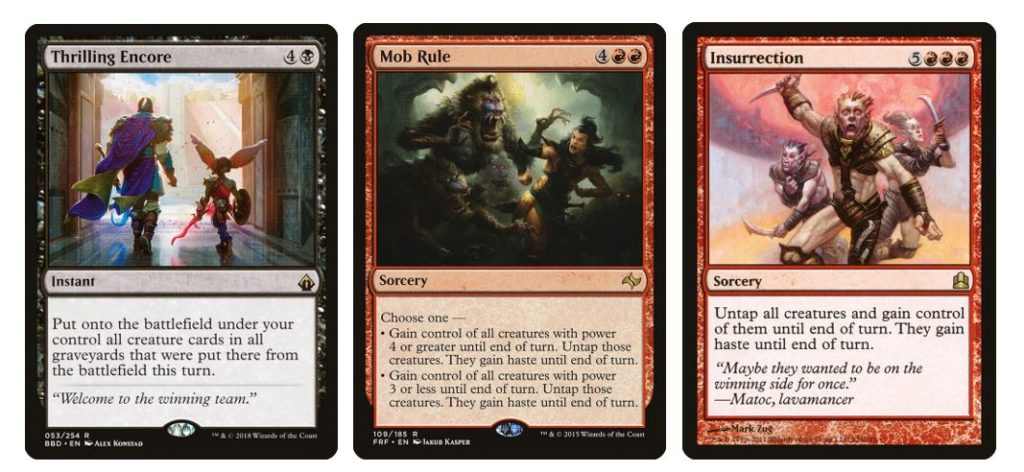
With hastey boards up, I would also say that classic threaten effects and some of their newer counterparts should be seeing more play right now. We’ve all seen how powerful clone-based Blue decks are at playing to the strengths of the table, and being able to Blasphemous Act and then play a Thrilling Encore can achieve a similar effect.
When we consider the increased power of creatures, the increased consistency of ramping into haymakers, and the likelihood that boards become thick with must-answer creatures at alarming rates? Well, Mob Rule is starting to look a lot more playable. It’s completely reasonable to expect to play this card on turn 6 or 7 and be able to eliminate at least one player.
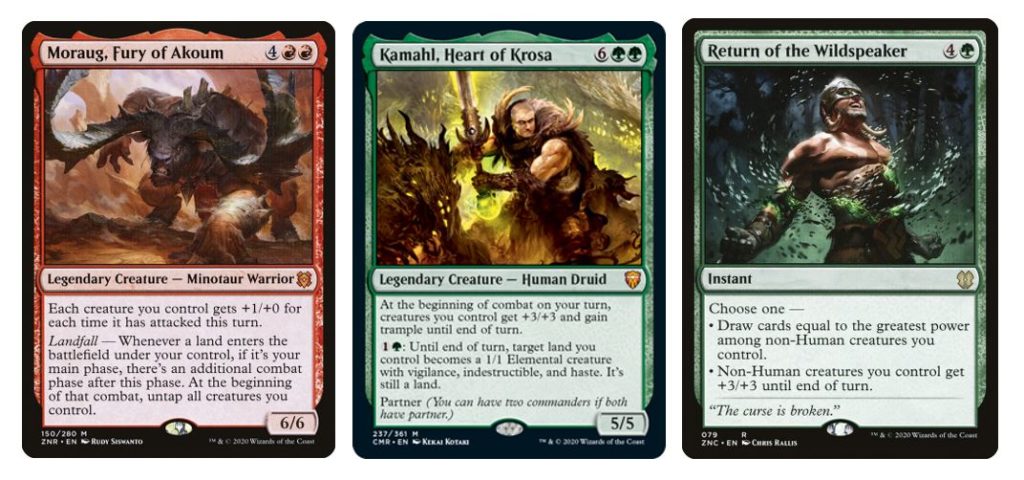
As the wider meta shifts, and the consistency of “overrun” effects increases, it can lead to games where life totals just melt. Having access to extra combats with Moraug as well as Waves of Aggression, or dropping Kamahl in a deck with access to Return of the Wildspeaker, it’s all the same — that ceiling is a lot easier to reach.
There’s also the fact that, when the smoke from all the one-for-one exchanges clears, and the board wipes have been played, it’s the players on the lowest life totals that are most at risk.
Lifelink
Enter Lifelink. Lifelink isn’t merely the domain of Lifelink decks, and I think people need to cotton on to just how great it is in casual Commander.
Haste is only useful if you’re still in the game, and even with the knowledge of how games play out in the new era of efficient removal and frequent alpha strikes, you’re no better off unless you do more to conserve your life total.
Far from just being a deckbuilding mechanic, including lifelink in your deck keeps you alive longer and lets you win games you otherwise shouldn’t.
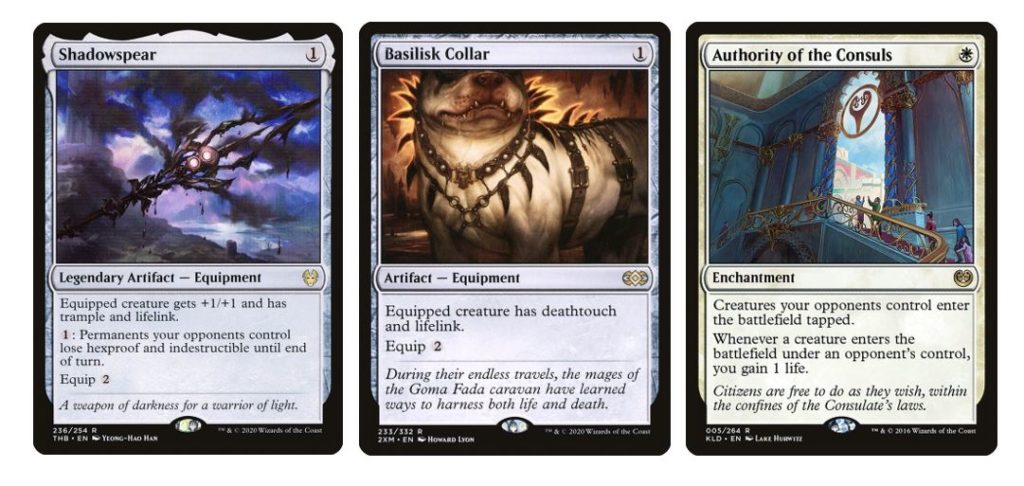
Shadowspear continues to disappoint because people are evaluating it on the wrong axis. Sure, the activated ability is great when it comes up, but that’s the gravy. Trample and Lifelink is what’s key, and the cost to use it is low enough that any creature-based deck can stand to benefit. Four life here, six life there — that’s what makes this card so great.
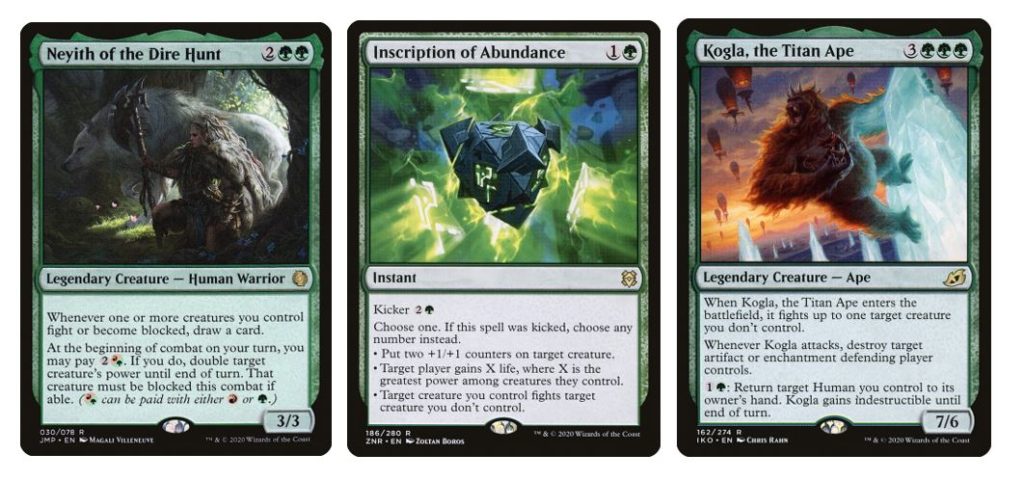
Similarly, cards like Basilisk Collar offer utility beyond Deathtouch in builds with fight spells. Playing Neyith this weekend, I was able to go from twenty four life to over fifty in the space of a turn cycle thanks to gaining life from Inscription of Abundance (kicked), gaining life from the ensuing fight, and gaining life from the combat step I took afterwards.
It was late in the game with players low on cards, and the tempo swing from gaining that much life made it close to impossible for the other players to win the game.
A lot of what makes lifelink good is that it can keep you “out of range.” When players are aware that their boards of creatures essentially have Vanishing counters on them due to the power of modern removal, they will want to convert those creatures into meaningful damage while they can.
While hitting the archenemy player or the control/combo player is often correct, when things are less clear, it’s the player on the lower life total that inevitably loses out. By making yourself harder to take out in one turn, you can often buy a turn to dig for more answers.

Gaining life is underrated in casual Commander, and I think you’re missing out. It’s not only the remit of dedicated lifegain decks, and taking incidental lifegain where you can is something you should consider.
A Note on Vigilance
Vigilance is a keyword I see bandied about as underrated quite frequently, and though I do think it’s pretty fantastic, its usefulness depends on just how much removal there is in your meta. Having vigilant creatures that are able to block isn’t worth much if they won’t be there when you untap.
The reason I believe effects like Haste and Lifelink are better right now hinges largely on what we’ve discussed today: namely, that games are shorter, creatures survive less frequently, and being on higher life totals is key to being able to survive the trials of the game.
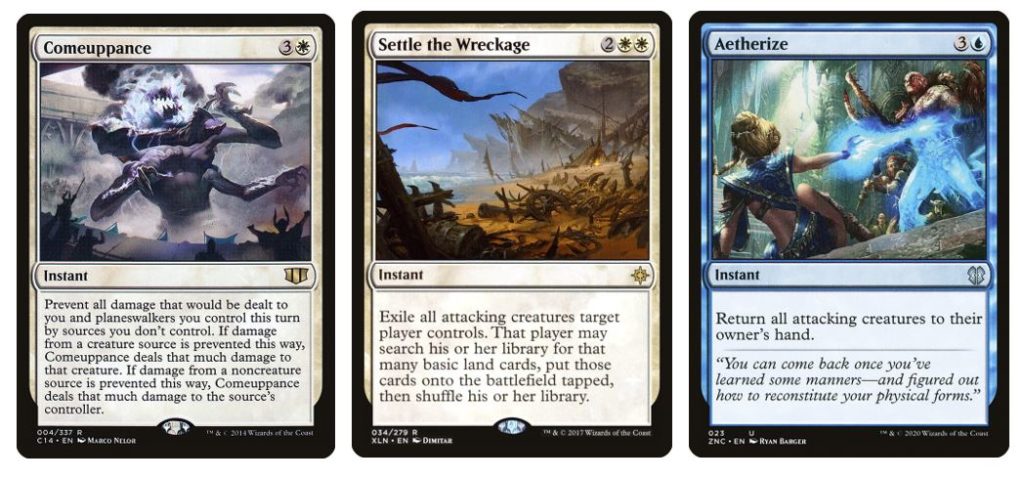
In essence, gaining life or dealing damage with your creatures and then leaving your defenses open can be mitigated — it’s about having ways to reduce that incoming damage while inflicting a loss of tempo on your opponents. It’s the reason why Cyclonic Rift is so powerful.
While I won’t advocate for too much Rift in casual games, I do think effects like Settle the Wreckage and Aetherize are key role players in decks that like to attack hard and fast.
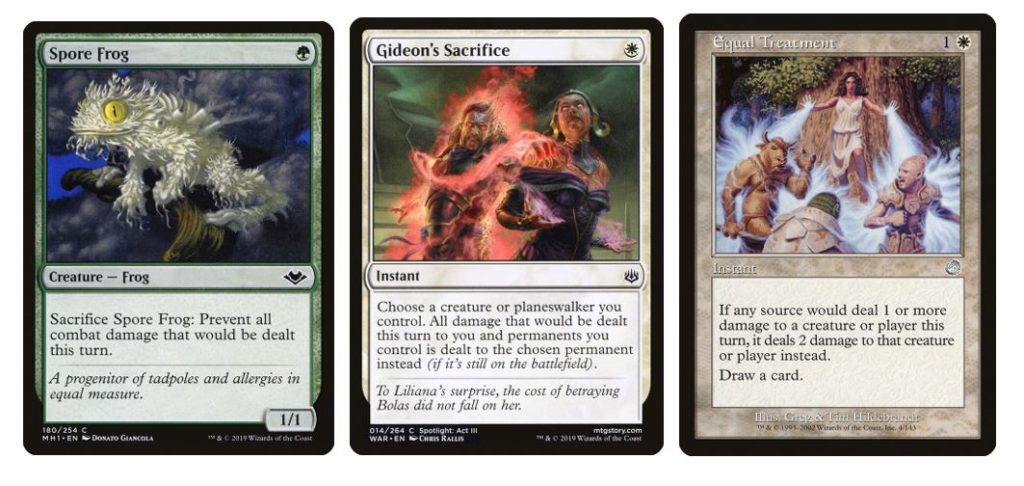
If holding up four mana seems like a lot, there are plenty more ways to nullify the “backswing.” Equal Treatment has long been a favorite of Sheldon Menery, and recently, I’ve found cards like Gideon’s Sacrifice are playable beyond merely enabling a Brash Taunter (though that’s a whole other level of fun!).
In Summary
Creature-based combat is what many love about Commander, and with creatures becoming more powerful every set, that combat can be brutal — and that’s if you even get to it. Removal is getting more efficient and plentiful, too, and being able to resolve a board of synergistic creatures gets harder as time goes on. While effects like Teferi’s Protection and Heroic Intervention can help get you there, it’s wise to think about just how much Haste can offer you in terms of getting value from the mana you spend.
Lifelink is likewise a powerful ability, and being able to recover from chip damage, playing shocklands, and otherwise provide a buffer for the late game where cards and answers are in short supply can be the difference between winning and losing a game.
The tips I’ve explained today only stretch as far as how casual your EDH pod is; if it’s all combos, you’re better off switching decks or asking your friends to switch instead. At higher-powered tables, your mileage may vary, but I still think if you’re aiming to play creatures at those tables that Haste is an underrated way to make that achievable.
Let me know on Twitter what you think the most underrated abilities are, and whether you think I’m on to something!

Kristen is Card Kingdom’s Head Writer and a member of the Commander Format Panel. Formerly a competitive Pokémon TCG grinder, she has been playing Magic since Shadows Over Innistrad, which in her opinion, was a great set to start with. When she’s not taking names with Equipment and Aggro strategies in Commander, she loves to play any form of Limited.

